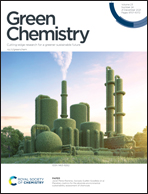Surface active ionic liquid assisted metal-free electrocatalytic-carboxylation in aqueous phase: a sustainable approach for CO2 utilization paired with electro-detoxification of halocarbons†
Abstract
Electrocarboxylation of halocarbons is a promising green synthetic strategy for capture, fixation and utilization of CO2 for the synthesis of high-added-value industrial compounds. However, the unparalleled kinetic/thermodynamic stability and solubility concerns of CO2 and halocarbons warrant the use of appropriate (often precious metal based) electrocatalytic electrodes and environmentally non-green solvent systems to drive this otherwise kinetically slow electrochemical process. Herein we demonstrate that owing to their unique solubility and excellent electrocatalytic properties, the aqueous micellar solutions of imidazolium-based surface active ionic liquids (SAILs) can be used for the efficient and selective electrocatalytic-carboxylation of halocarbons to produce carboxylic acids. Specifically, we present results from our detailed electrochemical investigations regarding the electroreductive cleavage of the C–X bond and electrocarboxylation of 9-bromoanthracene (9-BAN) and chloroacetonitrile (CAN) in buffered (pH 7, phosphate buffer) micellar solutions of 1-dodecyl-3-methyl-imidazolium chloride ([DDMIM][Cl]). We demonstrate that the unique ability of [DDMIM][Cl] micelles to stabilize the electrogenerated reactive intermediates facilitates a novel reaction pathway that ensures selective and efficient electrocatalytic-reductive carboxylation of 9-BAN and CAN. The presented results clearly establish that besides allowing for the electrocarboxylation of halocarbons in aqueous green electrolytes, the use of SAILs ensures electrochemical fixation of CO2 at practically low cost current and potential conditions imposed over metal free, economically viable and electrochemically robust carbon electrodes. The use of SAILs is reported to improve the faradaic efficiency (∼95%) and reduce the chances of undesired side product reactions which continue to be a major concern in the state of art electro-carboxylation processes. The presented approach we opine offers a promising avenue toward design of eco-green pathways in the direction of CO2 fixation and electro-organic synthesis of a diverse range of value-added products from water insoluble halocarbons (toxic pollutants) in aqueous media.



 Please wait while we load your content...
Please wait while we load your content...